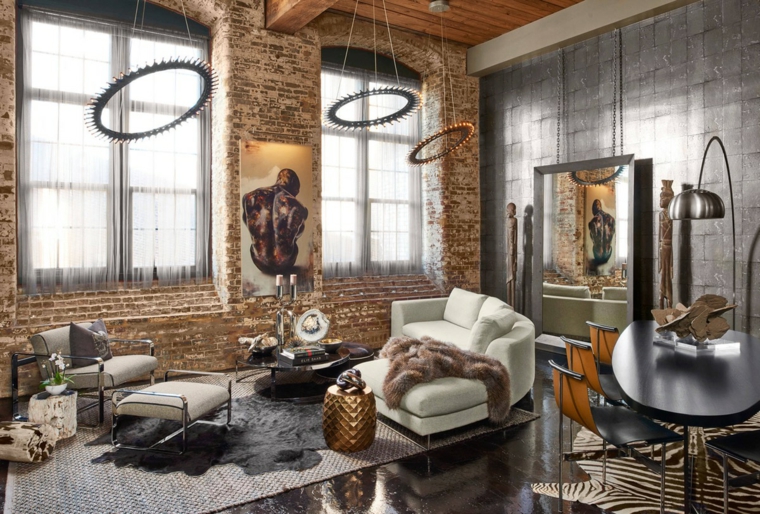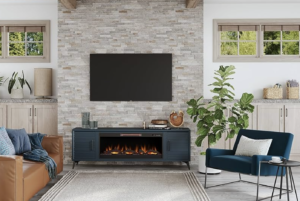
Industrial style has become the biggest interior design trend in the world right now, with no signs of abating. Who would have thought that the style of downtown warehouses, factories and loft apartments is now one of the most requested decoration trends for 5-star restaurants, CBD cafes and multi-million dollar mansions?

The industrial style celebrates sharp lines, stripped-down architecture, exposed surfaces, and salvaged vintage objects. It is a minimalist and functional style by nature, with a focus on displaying humble and functional materials.

Exposed brick, plumbing, and light cords are typical industrial design trademarks, however some may choose to have a more polished and elegant look rather than the typical gritty, unfinished look.

Although industrial design is predominantly masculine, it can be channeled into modern city chic with the right combination of softer materials and luxurious textures to add subtlety and femininity.

When creating a space with raw materials (new or used) try mixing them with other design styles to avoid making the space feel too cold. When dealing with materials like forged steel, aluminum parts, copper, weathered wood, and metal stools, for example, try combining them with solid padding, cushions, and upholstery pieces in natural textures for comfort.

When painting the walls (if you have the option to do so) consider leaving a feature wall with exposed brick. An even better alternative (especially for those who rent) is the use of wallpaper. There are great varieties available on the internet (some that mimic the look of bricks) and you will always have the option to remove them and replace them with another wallpaper design if you ever get bored.

When shopping for industrial furniture, try to get a design that also includes smart storage solutions. For example, vintage industrial wooden boxes can be organized into quirky storage units.

The best thing about industrial interior design is that you can achieve this look very easily on a budget. Look for antique, industrial-looking objects made of steel, metal, or wood; as well as worn items that have been reclaimed or recycled. And remember: this design is best paired with minimalism, so avoid having too much of everything.

Not much is known about the origin of the industrial interior design style. It is widely assumed that it developed in the early 20th century. At the end of the second industrial revolution, the trend towards globalization became even more pronounced. Western European factories closed down and moved their operations to low-cost countries. As a result, these empty buildings suffered neglect.

But these plants were perfectly suited for residential conversions. Over time, cities became larger and larger, leading to a lack of space for homes. Transforming the old industrial areas around the city into residential neighborhoods was a logical solution.
Brick walls

Industrial lofts often give us a great sense of space. Rather than hide the industrial past of these buildings, the architects and residents preferred to highlight it. The bare walls, rough ceilings, and large glass windows are evidence of past use of the plants. As a result, the industrial interior design style is full of character.
Typical elements of industrial-style interiors

Each style of interior design has specific elements. Scandinavian design generally prefers light colors and natural materials. An industrial interior, however, looks quite different.
Rough brick walls

There is no need for cosmetic tricks in the style of industrial interior design. In the majority of cases, the emphasis is on the resulting structures, including the walls as a whole. The ladders are made of a color of the interior and create a very cool and cozy atmosphere.
Industrial ladder wall

It is absolutely not necessary to use any wall paper or tapestry.
Concrete or made pieces

The menu does not have azulejos in an industrial interior. In general, the concrete has a concrete floor or concrete floor, which function only with the aspect of the interior of this terminal. You can choose between a range of colors for a specific color. The ends of the finished material work well for this style of interior design.
Concrete letter

For the general, see concrete and made pieces in this style of interior design. For the purpose of industrial sensation, many opt for solid concrete screws. This is a practical and economical option that fits perfectly with the theme. Tosquedad, their imperfections and parts do not make a difference. The effect is dissolving Aquellos that want to convey a layer of contrast and calibrate in an industrial interior design preferring only material or stone. Both options have different functions.
Open ceilings with beams and pipes

Industrial design is a relatively inexpensive interior design style because the ceilings are also exposed. Concrete columns, steel girders and girders, as well as ventilation pipes are not hidden, but stand out. The ceiling is often painted black to add a sense of depth or hide something. You do not need to hide the water or ventilation pipes.
Large steel windows

In line with the industrial past of buildings, retro windows work very well in these types of interiors. Windows are generally made of steel and have several smaller panels. These factory windows are often quite large, letting in a lot of light.
Open plan

An industrial interior is all about space. That is why an open floor plan, such as in a loft, is a good option. Use wooden screens or cabinets to subdivide the space. There are no separate spaces, everything is one large living room.
Dark furniture

A leather sofa works great in this design style. But the fabric looks just as good. Keep in mind that flashy and flashy colors do not go with this style. Grays, often on the darker side of the spectrum, are a better option. Strong, dark colors are typical for this style.

Furniture may have some wear and tear. Just think of a coffee table made from recycled pallets or a vintage metal cabinet with paint scraped off. Second-hand furniture is a good idea to decorate an industrial-style home.
Limited decoration

The decoration in this type of home is generally reduced to the essentials. Here you will not find hundreds of plants, frames, figurines, pots … Instead, the motto is less is more. Decor is often kept to a minimum in industrial-style interiors.
Simple steel stairs and railings

The concept of openness applies to the length, width and height of the space. Often architects design an open duplex, in which the levels are connected with simple steel stairs. There are no fancy wooden stairs here. The railings on the landing are generally very simple and angular.
Industrial lighting

There is one element that we have not discussed yet: lighting. Here are some examples of stylish industrial lighting.

This is a challenging look, but there are a plethora of lighting options available today. Floor lamps and pendants are widely used in industrial design spaces for focused lighting. Tracking lights are a good choice for ambient lighting. Recognizing the emergence of trends in industrial interior design, more and more retailers are selling distressed metal pendants or earrings and floor lamps that are perfect for such rooms.

The delicious interplay of grainy, earthy wood texture and smooth, shiny metal is a very popular industrial interior design trend.

Many choose to expand the presence of metal by selecting high-gloss steel or chrome accents in the kitchen and for light fixtures.
Color in industrial interior design

Warm, neutral colors are generally preferred for industrial-style homes, which are typically large and open. Such shades help bring visual warmth to an area that might otherwise be overwhelmed by the coolness of metal pipes and ducts. Shades of gray work great.
Industrial interior design walls

Many lofts and old factories that are converted using industrial interior design ideas come with a brick or concrete wall that can become a striking feature in the redesigned space.

This is a huge plus because it stands out as an eye-catching attribute that is a conversation piece. If it doesn’t look worn enough, give it a more distressed look to maximize the drama.

All of those exposed structural elements would be overwhelming if it weren’t for the softness-infused decor used in industrial home design. Plush sofas, scatter cushions, and rugs provide visual balance by contrasting sharply with industrial features.

Plants also add warmth to contemporary industrial design. When it comes to plants, the bigger the better the formula to adopt for industrial design, otherwise they would get lost in the big space.

So now that you know the basics, how do you begin your personal journey to industrial interior design? It is always a good idea to visit some historical buildings and see how they have been reinvented in modern times.

Downtown areas of the city and manufacturing centers generally have a rich harvest of such structures where you can see the beauty of exposed and aged brick walls, wooden ceiling beams and panelless steel columns. cast. Many of these old buildings are now being converted into luxury condominiums and offices.

If you’ve been a longtime fan of this genre of interiors, you probably already own some pieces that incorporate all the best in industrial design, such as indirect-purpose vintage furniture, scissor or pulley accordion lighting – pieces that proudly display your inner workings, leaving nothing to the imagination.

Use these objects you love as inspiration, as starting points for your design vision. Put together a humor chart or book of looks to keep track of all the ideas you like, so that you can employ as many of them as possible.

Starting with an empty loft space is ideal if you want to use industrial interior design trends because you essentially have a blank canvas.

If you are renovating your home to achieve the look, it is a bit more challenging. You have the option of introducing an element or two elements of industrial design or walking the entire nine meters and completely reworking the space.

A small infusion of this industrial interior design style could be executed by re-looking at a fireplace and accent wall with exposed materials while leaving the rest of the room modern. Therefore, you will end up having a modern industrial home. Concrete is a fabulous and inexpensive option for industrial interior design. It can be polished to a high gloss or matte or unfinished for a more rustic appeal. Large bulb industry inspired yarns bring a magical glow to patios, decks, pergolas and gazebos. Most lighting retailers have industrial design inspired outdoor fixtures. While there are some basics to consider if you want to go down the industrial interior design path, it is important to remember that there is room for some flexibility.




